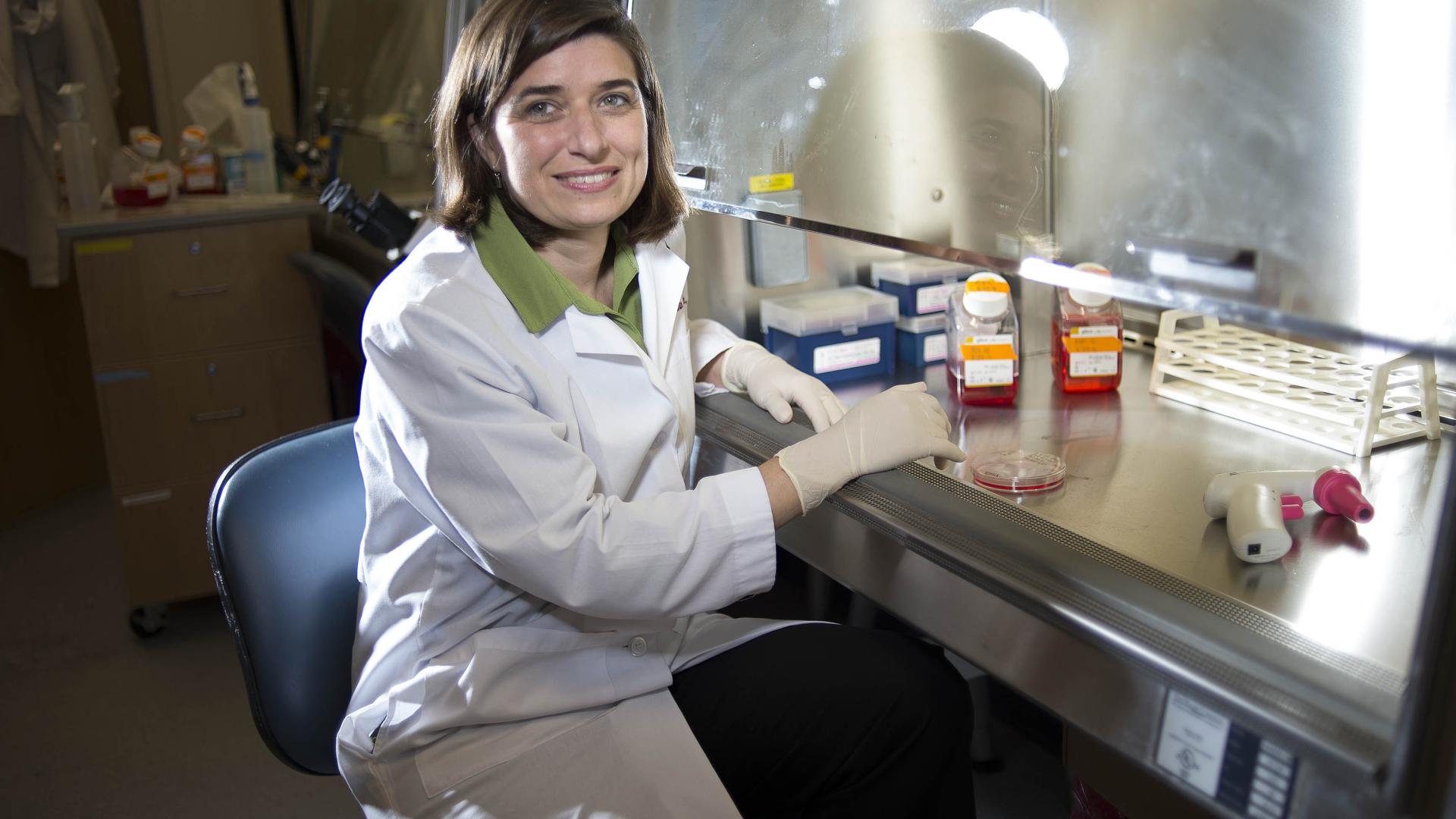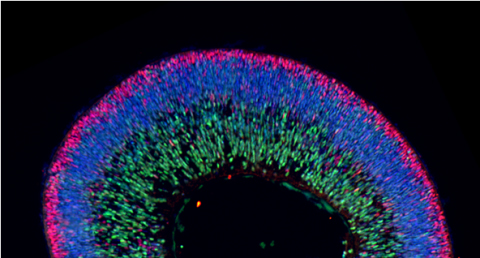Rise in Drusen-Related Proteins May Signal Early AMD
Written By: BrightFocus Editorial Staff



Written By: BrightFocus Editorial Staff

Former BrightFocus grantee, Maria Valeria Canto-Soler, PhD, and colleagues at the University of Colorado, including lead investigator Miguel Flores-Bellver, PhD, have shown that retinal pigmented epithelial (RPE) cells continually release exosomes, or nanosized cell particles, that carry genetic information and proteins to neighboring cells. Under normal conditions, these exosomes contain both normal proteins and proteins associated with drusen – the fatty deposits that can build up in the retina as an early indicator of age-related macular degeneration (AMD).
However, under stressful conditions, including when they are exposed to an environment like that of AMD, RPE cells respond with a dramatic increase in the release of drusen-associated proteins via exosomes.
These discoveries were made using a cell model Dr. Canto-Soler developed as a BrightFocus grantee. If successfully applied, the findings could lead to much earlier diagnosis of AMD, potentially at the time of onset, as well as new treatments targeting the earliest stages.
Their results were published in the Journal of Extracellular Vesicles on Nov. 8, with Dr. Canto-Soler as senior author and Dr. Flores-Bellver as first author (Flores-Bellver et al, 2021).
It is generally thought that AMD begins in the RPE, a single layer of cells that line up in a honeycomb pattern next to the retina. The RPE’s job is to transport molecules in and out to nourish the retina and dispose of waste – a function that can be compromised by age, oxidative stress, inflammation, and other factors related to the immune system.
These researchers found that in conditions like those experienced in AMD, RPE cells release drusen-associated proteins about 20 times more often than in normal conditions. “It opens the possibility for early diagnosis of a person developing AMD by determining that their cells are secreting a lot more exosomes with these drusen-associated proteins than in normal conditions,” Canto-Soler said in a statement.

For years, researchers have been searching for the origins of drusen-associated proteins found in AMD. And now, if tests can be developed to measure the drusen-related proteins released in exosomes from the RPE, those results could be used to diagnose the disease early, perhaps even at the time of onset.
The discovery also opens up the possibility of new therapies for AMD at early stages, which could help prevent a devastating form of late AMD known as geographic atrophy (GA). Currently the only available treatments for AMD consist of eye vitamins for AMD in intermediate stages (known as the Age-Related Eye Disease Study 2, or AREDS2, regimen), and for wet AMD (a less common late-stage form), injections of drugs that prevent growth of fragile, leaky blood vessels that interfere with vision and can lead to cell death. There is currently no treatment for GA, although several are in development.
“If we understand how drusen form and what cells or mechanisms contribute to their formation, we may be able to control the formation of drusen and slow down or even, perhaps prevent, some of the pathological events leading to AMD,” explained Canto-Soler.
Her colleague, Flores-Bellver, said it may be possible to develop “new tools to target and modulate exosome release and protect the cells from the accumulation of drusen under the retina.” If so, it would be a game changer in terms of preventing vision loss from AMD.
Dr. Canto-Soler grew up in Argentina where, as a biology student, she dreamed of a career studying elephants and African wildlife in their native habitat.
“Instead of spending my life studying animals in the wilds of Africa, I’m in a dark room sitting in front of a microscope,” she joked in a 2017 interview.
However, she also was drawn to understanding how human sensory organs, including eyes, work. During her last two years as a biology student at the University of Cordoba, she worked in a lab studying the human nervous system, “That defined my future,” she recalled. She went on to earn a PhD in Biomedical Sciences at the Austral University School of Medicine in Buenos Aires.
In 2016, as a researcher at the Wilmer Eye Institute of Johns Hopkins University in Baltimore, Dr. Canto-Soler received her BrightFocus Macular Degeneration Research grant, the Helen Juanita Reed award. Her project was to develop the first “retina-in-a-dish” model to study AMD.
Human organoid models like the one she envisioned are created using induced pluripotent stem cells (iPSC) techniques, and essentially consist of growing and reprogramming cells found in adult human tissue. Within recent years, they have become prevalent research tools for studying disease origins and experimental cures. And Canto-Soler’s retina-in-a dish model was among the first in the macular field. In her BrightFocus grant profile, she describes the technique for creating models using iPSC techniques.
In 2017, Canto-Soler joined the faculty of the Colorado University Anschutz School of Medicine as associate professor of Ophthalmology and the Doni Solch Family Endowed Chair in Ocular Stem Cell Research at the university’s Gates Center for Regenerative Medicine. Canto-Soler
also was named director of CellSight, an ocular stem cell and regeneration program whose end goal is to advance iPSC techniques to treat vision loss from AMD. Dr. Soler-Canto carried her BrightFocus grant into her expanding research career and finished the project.
Recently, at the International Symposium on Retinal Degeneration (RD2021) held this past fall, Dr. Canto-Soler gave a talk and described how far she has taken her original “retina-in-a-dish” model.
Among other things, her lab has been the first to generate photoreceptors—a part of retinal nerve cells responsible for processing incoming light signals.

The ultimate goal is to be able to transplant parts of the retinal machinery that are no longer functioning in order to restore sight.
Clearly, Dr. Canto-Soler and her team are advancing on all fronts towards better diagnosis, prevention, and treatment of AMD, and farther ahead, towards the restoration of sight. And the story begins with her BrightFocus-funded cell model.
In closing, “I have become quite an optimist,” Dr. Canto-Soler told the RD attendees. “I really didn’t think you could regenerate retinal layers and photoreceptors that respond to light.
“But seeing how plastic cells are, things you never thought were possible may actually happen!”
BrightFocus Foundation is a premier global nonprofit funder of research to defeat Alzheimer’s, macular degeneration, and glaucoma. Through its flagship research programs — Alzheimer’s Disease Research, Macular Degeneration Research, and National Glaucoma Research— the Foundation has awarded nearly $300 million in groundbreaking research funding over the past 51 years and shares the latest research findings, expert information, and resources to empower the millions impacted by these devastating diseases. Learn more at brightfocus.org.
Disclaimer: The information provided here is a public service of BrightFocus Foundation and is not intended to constitute medical advice. Please consult your physician for personalized medical, dietary, and/or exercise advice. Any medications or supplements should only be taken under medical supervision. BrightFocus Foundation does not endorse any medical products or therapies.
